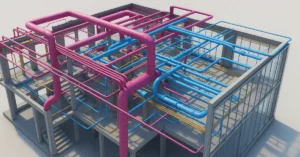The Impact of BIM on India’s Construction Industry
Building Information Modeling (BIM) has emerged as a revolutionary force in the construction industry globally, and its impact on India’s construction sector has been significant. BIM is a digital representation of physical and functional characteristics of a facility. It provides a shared knowledge resource for information about a facility, forming a reliable basis for decisions during its lifecycle, from inception onward. In India, where the construction industry is a major contributor to the economy, the adoption of BIM is transforming how projects are designed, constructed, and managed. This blog will explore the multifaceted impact of BIM on India’s construction industry, covering its benefits, challenges, and future prospects.
The Evolution of BIM in India
The construction industry in India has traditionally been characterized by conventional practices, which often led to inefficiencies, cost overruns, and delays. However, with the advent of BIM, the industry is experiencing a paradigm shift. The journey of BIM adoption in India began slowly but has gained significant momentum over the past decade.
Initially, BIM was perceived as a tool for large-scale projects by multinational companies operating in India. However, as local firms recognized its potential, the adoption rate increased. Government initiatives, such as the Smart Cities Mission and various infrastructure projects, have further accelerated the adoption of BIM. These projects require a high level of coordination and precision, making BIM an invaluable tool.
Benefits of BIM in India’s Construction Industry
1. Improved Collaboration and Communication
One of the most significant benefits of BIM is enhanced collaboration and communication among project stakeholders. BIM facilitates a collaborative approach by providing a common platform where architects, engineers, contractors, and clients can work together seamlessly. This collaborative environment helps in identifying and resolving potential issues early in the design phase, thereby reducing costly changes during construction.
2. Enhanced Visualization
BIM provides detailed 3D models that offer a comprehensive visual representation of the project. This visualization capability allows stakeholders to understand the design intent better and make informed decisions. For instance, clients can visualize the final product before construction begins, enabling them to provide valuable feedback and request changes early in the process.
3. Increased Efficiency and Reduced Costs
BIM helps in optimizing the construction process by enabling precise planning and scheduling. This leads to reduced material wastage, better resource management, and minimized delays. The accurate cost estimation and quantity take-offs provided by BIM also help in keeping the project within budget. According to a report by the National Institute of Building Sciences, projects using BIM can see cost savings of up to 20%.
4. Improved Quality and Safety
BIM allows for detailed analysis and simulation of construction processes, which helps in identifying potential risks and safety issues. By addressing these issues in the design phase, the quality of construction improves, and the risk of accidents on site is significantly reduced. BIM also facilitates better compliance with safety regulations and standards.
5. Lifecycle Management
BIM is not limited to the design and construction phases; it extends throughout the lifecycle of the building. Facility managers can use BIM data for maintenance, operations, and future renovations. This holistic approach ensures that the building remains functional and efficient throughout its life.
Challenges in BIM Adoption in India
Despite the numerous benefits, the adoption of BIM in India faces several challenges. These challenges need to be addressed to fully realize the potential of BIM in the construction industry.
1. Lack of Awareness and Training
One of the primary challenges is the lack of awareness and understanding of BIM among industry professionals. Many stakeholders are still unfamiliar with the concept and benefits of BIM. Additionally, there is a shortage of skilled professionals who can effectively implement and manage BIM processes. Training and educational programs are essential to bridge this knowledge gap.
2. High Initial Costs
Implementing BIM involves significant initial investment in software, hardware, and training. Small and medium-sized enterprises (SMEs) often find it challenging to bear these costs. However, it is important to note that the long-term benefits and cost savings of BIM can outweigh the initial investment.
3. Resistance to Change
The construction industry in India has been following traditional practices for decades. Introducing a new technology like BIM requires a cultural shift and a willingness to embrace change. Resistance from stakeholders, especially those who are comfortable with existing methods, can hinder the adoption process.
4. Interoperability Issues
BIM involves the use of various software and tools for different stages of the construction process. Ensuring seamless interoperability between these tools can be challenging. Standardization of data formats and protocols is essential to facilitate smooth data exchange and collaboration among different software platforms.
5. Regulatory and Policy Support
While the government has initiated several projects that promote the use of BIM, there is still a need for comprehensive regulatory and policy support. Clear guidelines and standards for BIM implementation can provide a framework for the industry to follow, ensuring consistency and quality.
Case Studies: BIM in Action in India
To understand the impact of BIM on India’s construction industry, it is useful to look at some successful case studies where BIM has been implemented effectively.
1. Delhi Metro Rail Corporation (DMRC)
The Delhi Metro is one of the largest and most complex infrastructure projects in India. The DMRC adopted BIM for the planning, design, and construction of its Phase III expansion. BIM enabled better coordination among various stakeholders, improved design accuracy, and streamlined construction processes. The use of BIM resulted in significant cost savings, reduced project timelines, and enhanced quality control.
2. Infosys’ Global Education Centre
Infosys, one of India’s leading IT companies, used BIM for the construction of its Global Education Centre in Mysore. The project involved the construction of a large campus with multiple buildings and infrastructure. BIM helped in optimizing the design, reducing material wastage, and improving construction efficiency. The project was completed ahead of schedule and within budget, demonstrating the effectiveness of BIM in large-scale construction projects.
3. Smart Cities Mission
The Smart Cities Mission, launched by the Government of India, aims to develop 100 smart cities across the country. BIM is playing a crucial role in the planning and implementation of these projects. By providing a digital representation of the urban infrastructure, BIM helps in better planning, resource management, and coordination among various agencies involved in the development of smart cities.
The Future of BIM in India
The future of BIM in India looks promising, with increasing adoption and awareness among industry stakeholders. Several trends are expected to shape the future of BIM in the Indian construction industry.
1. Integration with Emerging Technologies
BIM is expected to integrate with other emerging technologies such as Artificial Intelligence (AI), Internet of Things (IoT), and Augmented Reality (AR). These technologies can enhance the capabilities of BIM by providing real-time data, predictive analytics, and immersive visualization. For instance, IoT sensors can provide real-time data on building performance, which can be integrated into the BIM model for better facility management.
2. Government Initiatives and Policy Support
The government’s role in promoting BIM will be crucial for its widespread adoption. Policies and regulations that mandate the use of BIM for public projects can drive the adoption of BIM in the private sector as well. Additionally, government support in terms of funding for training programs and infrastructure development can help in overcoming some of the challenges associated with BIM adoption.
3. Increased Collaboration and Standardization
As the adoption of BIM grows, there will be a greater emphasis on collaboration and standardization. Industry stakeholders will need to work together to develop common standards and protocols for BIM implementation. This will facilitate seamless data exchange and collaboration among different parties, ensuring consistency and quality across projects.
4. Focus on Sustainability
Sustainability is becoming a key focus area in the construction industry. BIM can play a significant role in promoting sustainable construction practices by enabling better resource management, reducing waste, and improving energy efficiency. The use of BIM for lifecycle management of buildings can also contribute to sustainability by ensuring that buildings are maintained and operated efficiently throughout their lifecycle.
Conclusion
Building Information Modeling (BIM) is transforming India’s construction industry by enhancing collaboration, improving efficiency, and ensuring better project outcomes. Despite the challenges, the adoption of BIM is on the rise, driven by government initiatives, industry recognition of its benefits, and the increasing demand for sustainable and smart construction practices. As the industry continues to evolve, BIM will play a crucial role in shaping the future of construction in India, paving the way for a more efficient, sustainable, and collaborative industry.
If you’re interested in learning more about architecture firms in Europe, check out this comprehensive list of the top 50 firms compiled by Archgyan. From innovative startups to long-established industry leaders, this list has it all. Take a look and discover some of the most inspiring and influential architecture firms in Europe today.
If you’re interested in architecture and want to learn more about this amazing field, subscribe to our podcast on youtube
For more SketchUp tutorials, head to https://www.sketchupguru.com










